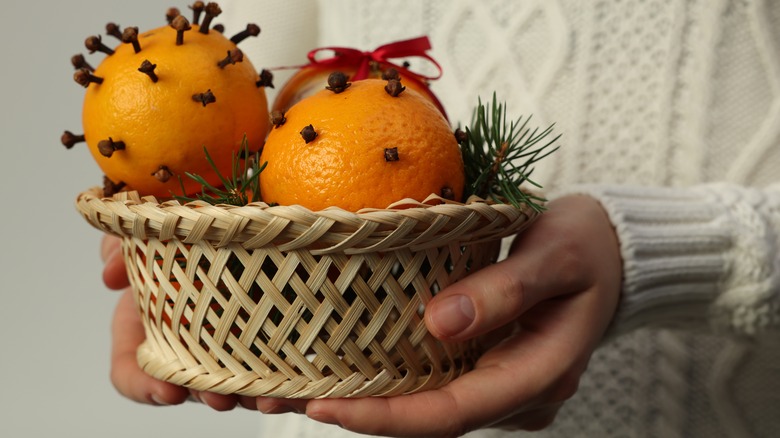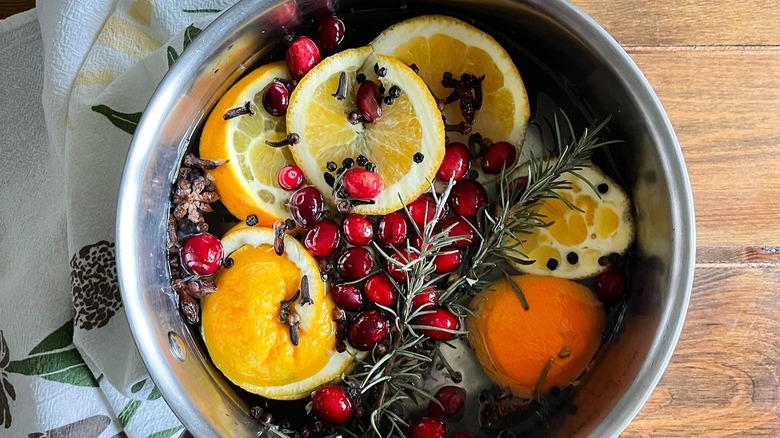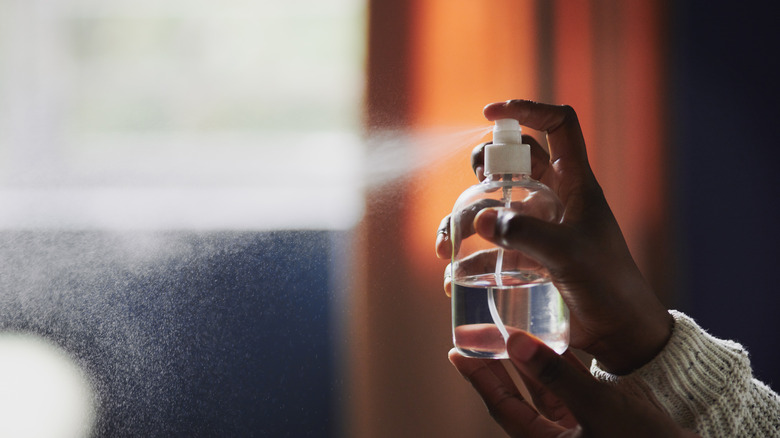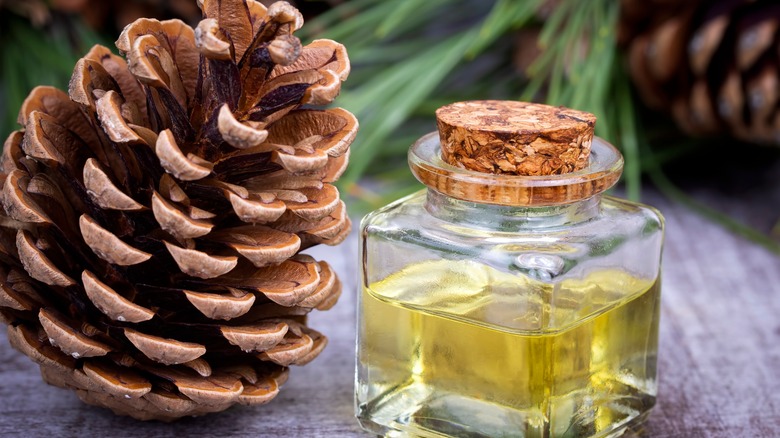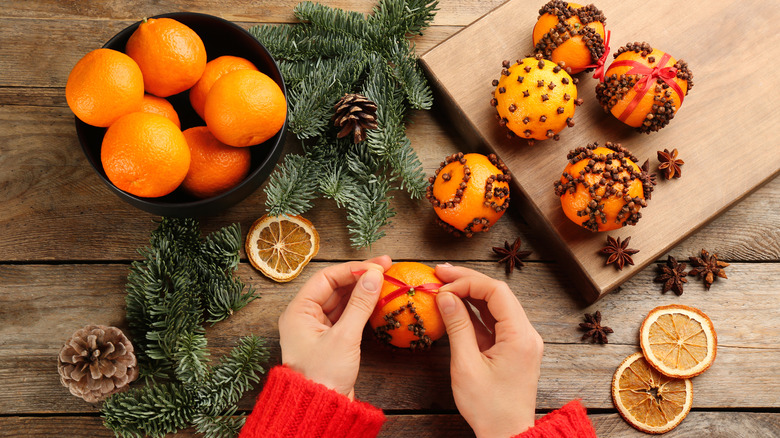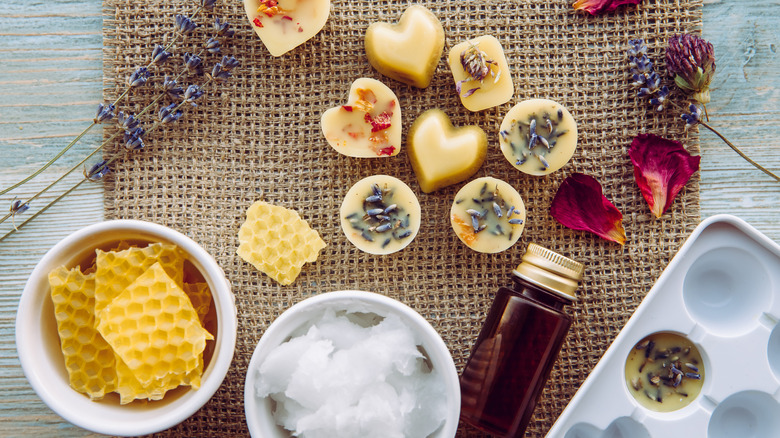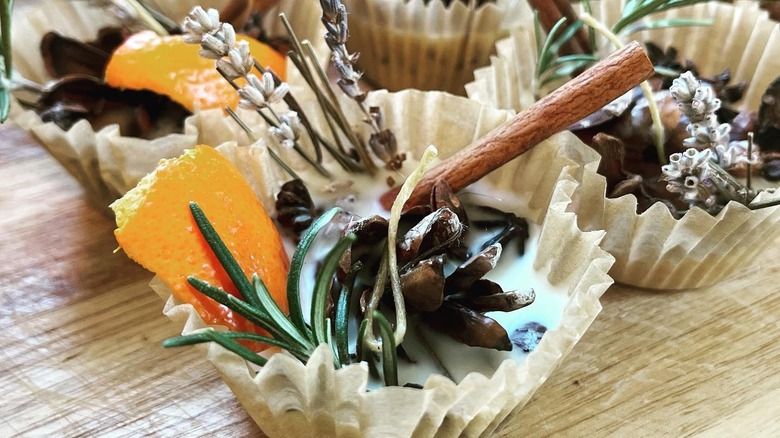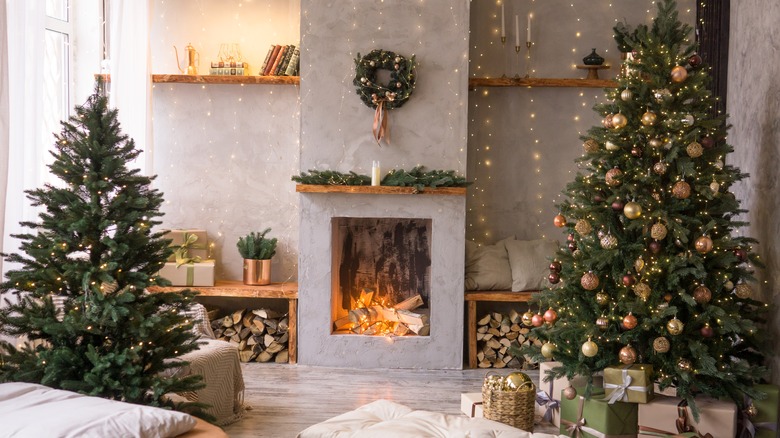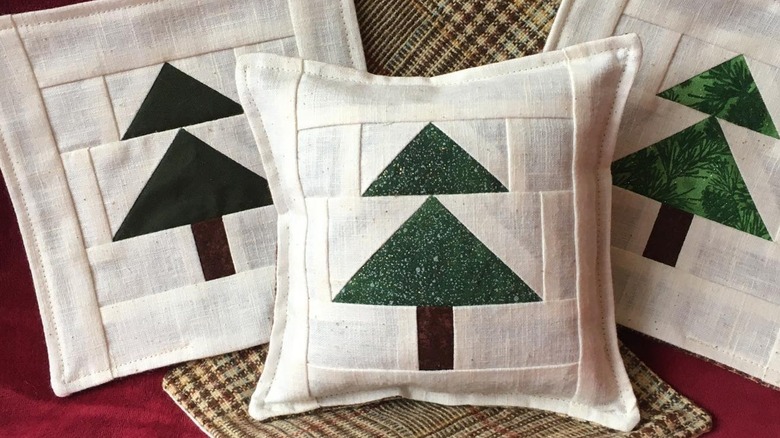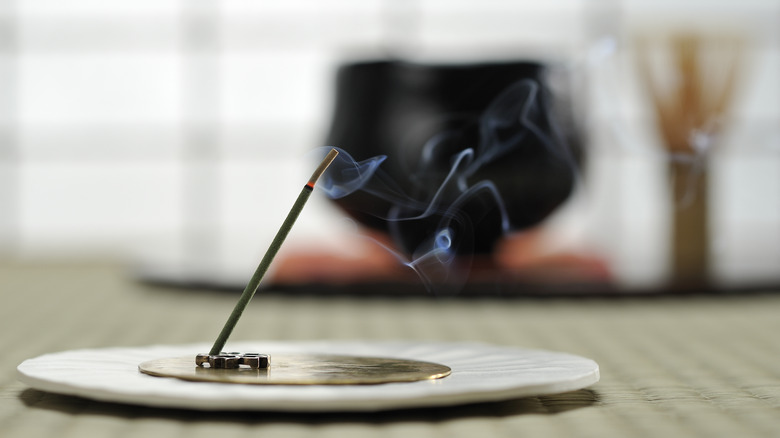Ditch Candles And Use These Sustainable Alternatives For A Seasonal Home Aroma
Whether you're a fan of zesty orange, refreshing wintergreen, or woody pine, scented candles are one of the easiest ways to make your home smell like the holidays. However, they actively contribute to pollution, negatively impacting the environment. That's because most candles are made of paraffin wax, which is derived from petroleum. Because of this, when it burns, it releases air-harming byproducts like formaldehyde, carcinogens, fragrant hydrocarbons like toluene, and volatile organic compounds (VOCs), which degrade your indoor air quality (IAQ). And as you can imagine, they're not great for your health, either. Luckily, there are various eco-friendly ways to enjoy an aromatic holiday season without compromising your well-being or sustainability goals.
For instance, simmering a pot with seasonal classics — like orange, cinnamon sticks, and rosemary sprigs — will make your interiors smell wonderful in no time. Similarly, you can add a few drops of your favorite essential oils to unscented pine cones to get into the holiday spirit and revel in the scent-induced memories. Besides being eco-conscious, these alternatives give you the opportunity to customize the scent and its potency per your preferences. Better yet, you can DIY a few alternatives on a budget, such as pomander balls and homemade balsam pillows. Excited to form some new memories tied to the delightful aromas wafting around your house? Here are 11 sustainable alternatives to scented candles for a seasonal home aroma.
Simmer a pot with your favorite ingredients for a fragrant home
There are multiple reasons a simmer pot is a sustainable solution for a fragrant home. Unlike synthetically scented candles, it only requires natural ingredients, so there's no danger of VOCs. Moreover, a single pot can be used for two to three days straight; you just have to add water. Refrigerated pots might even last up to seven days. Plus, it's an economical solution since you can use whatever items you have on hand, including cinnamon sticks, cloves, and oranges. You can even use scraps, like citrus peels, instead of throwing them away. Bonus: Simmer pots add moisture to the dry winter air.
The first step is to find a pot, mini Dutch oven, slow cooker, or saucepan to simmer your favorite holiday ingredients. Pour water inside the pot till it's half or ¾ full. Substitute the water with apple juice for a sweet-smelling base. For a Christmas simmer pot recipe to give your house a refresh, add 2 to 5 rosemary sprigs, a sliced orange (peels work, too), 2 star anise, a cup or two of fresh cranberries, 3 to 4 cinnamon sticks, and 10 whole ground cloves. Apple or pear slices, nutmeg, pine needles, thyme, vanilla extract, and ginger are a few other items you can add to the pot. Boil the concoction, and turn the heat to low to let it simmer for a few hours and aromatize your interiors. Keep adding water to the pot when the liquid is close to evaporating.
Create a room spray free of synthetic scents
Aerosol sprays have been used since the mid-20th century to deodorize homes and are considered a great alternative to scented candles. However, they can emit VOCs, phthalates, solvents, and other pollutants. These chemicals aren't just bad for your health but also the environment. So, create your own oil-based room spray to perfume your indoors this holiday season. Essential oils are considered safer than candles because they are not derived from petroleum and most don't contain synthetic ingredients. However, since essential oils aren't regulated in the U.S., it's important to look for "100% pure essential oil" on the label and check the listed ingredients to ensure you're getting the real deal. If you don't, you might choose one with added chemicals, making it less eco-friendly.
Although essential oils are cleaner than paraffin wax, undiluted oils can still irritate people with respiratory conditions. For this reason, it's important to always dilute them with water or a carrier oil, or avoid using them if you have someone with asthma or a lung condition in your home. If an essential oil spray is right for you, you'll need a glass spray bottle (undiluted essential oils can dissolve the plastic ones with time). It's also best to get dark-colored bottles, like Hydior's 4-ounce 2-bottle set with a funnel and dropper from Amazon. They look chic and will keep your DIY room freshener safe from UV rays. For the spray, grab your holiday favorite essential oils, such as orange, cinnamon, clove, spruce, cedar, pine, peppermint, myrrh, and frankincense, to scent your home. Use distilled water as your spray's medium. Finally, use a tablespoon of witch hazel or vodka as an emulsifier to effortlessly combine the oils with water. If you have neither handy, a pinch of salt works, too. Fill the spray bottle halfway with water, add your emulsifier of choice, put in 10 to 20 drops of your favorite essential oil(s), and pour some water again, leaving a little space at the top. Shake the bottle well. Your non-toxic room freshener is ready! Just be careful not to spray near upholstery, as oils may stain.
Turn regular pine cones into scented ones
If you have a few pine trees in your yard, turn the fallen pine cones into scented decor instead of using them all as mulch. Cones from conifers like fir, spruce, and hemlock work, too. In case you don't grow such trees or have a yard, ask your local parks department if you can take some or ask your friends and family. These scented cones are sustainable alternatives to synthetic candles since they're natural, last long, and can be re-scented once they lose their fragrance.
Once you have enough good-looking cones, give them a soapy bath or let them soak in warm water for a while. This will remove the lingering dirt, sap, and get rid of the critters hiding in the folds. Dry them by setting them on a towel, and let them take a sunbath for a couple of hours. But, if the weather has turned, and the sunlight isn't strong, put the cones on a foil- or parchment-lined baking sheet. Then, set the oven to 200 degrees Fahrenheit, and put them in for around 30 minutes. Now, let them cool, place them in a Ziploc bag, and coat them in your favorite essential oil blend. Close and shake the bag, then set it aside for a week or two before placing it around your home. If this seems like too much work, make your own scented pine cones with a dash of cinnamon. Keep them away from flammable sources and curious kids and pets.
Curate a potpourri for your living room with carefully chosen ingredients
Potpourri is an old-school way to keep your home smelling fresh. So, why not use it to aromatize your home this holiday season? It's sustainable since you'll be using natural ingredients such as dried flowers, leaves, herbs, and spices. When using flowers and leaves from your garden, dry them in the sun or in the oven. Alternatively, dry your own homegrown herbs with one laundry room essential. Potpourri's fragrance lasts long, and you can re-scent the mixture using essential oils once it loses its potency. Plus, a well-curated potpourri looks gorgeous and will spruce up your living room.
Since it's a treat for your nose as well as your eyes, pay attention to the scent profile, but also look at the colors of your ingredients, and visualize how they'll look together before mixing them. Choose among cinnamon sticks, pine needles, sprigs of rosemary, whole cloves, vanilla beans, star anise, dried orange, lemon slices, allspice berries, patchouli leaves, rose petals, hibiscus flowers, and more. You'll also need your favorite essential oil(s) and natural fixative powder, such as orris or angelica root powder, to keep your potpourri's smell intact. Now, layer the dried ingredients in a bowl or jar. Then, add 10 to 20 drops of the oil to the fixative powder (1 tablespoon per 4 to 5 cups of ingredients), and mix it in. However, keep your homemade potpourri away from your pets and kids.
Craft pomander balls to lend a charming touch to your holiday preparations
HGTV's Erin Napier has the perfect scent for your home this holiday season: cloves and orange. Incorporate this scent into your interiors without spending a lot of money by crafting pomander balls. A sustainable alternative to scented candles, these balls only require whole oranges and cloves. This is an easy and fun DIY project for you to get your kids involved with, too.
To craft pomander balls, you'll need oranges (or grapefruit or lemons), a bag of cloves, a few paper towels to absorb the fruit's juice, and a wooden skewer or toothpick to poke holes into the fruit. Before you start, determine how you want to use each ball. Do you want to hang a few from your Christmas tree, or simply arrange them around your mantle, entryway, and living room? In case you want to hang them, tie a ribbon beforehand. Additionally, pick a design for the cloves, like swirls, straight lines, diamonds, or stars. Then, poke holes in the fruit's surface based on your design choice and keep lodging cloves inside. Your pomander balls are ready! For a stronger scent, roll the balls in a powder made of your favorite holiday ground spices, such as cinnamon, nutmeg, cloves, allspice, ginger, and orris root. Or, create dried pomander balls by placing them in a paper bag for two to three weeks. Freshen up the brown ones using distilled water and clove essential oil.
DIY adorable wax melts with sustainable ingredients
Packaged wax melts are often manufactured using similar synthetic ingredients to scented candles, so using store-bought varieties is probably a no-go for a sustainable approach to the holidays. However, you can DIY wax melts with eco-friendly ingredients, like beeswax and organic essential oils, to perfume your interiors. Besides being free of synthetic chemicals, they last longer than candles. Plus, adding a few drops of essential oils to the melted wax will help you elongate the lifespan of each wax melt. You can also freeze the top of your wax warmer, slide out the hardened wax, and remelt it. The best part, though? They're flameless, so they melt without producing smoke.
For this DIY, you'll need to melt some beeswax. Let the liquified wax cool down completely before adding a substantial amount of essential oil, around 40 to 100 drops to the wax, based on how potent you want the smell to be. You don't have to stick to a single scent. Blend a few to customize the fragrance per your holiday vibe. Now, pour the wax into seasonal silicone molds (or ice cube trays or cupcake liners) and set it aside for a few hours to harden. Fill each compartment ¾ full since wax will expand as it sets. Store each melt in an airtight jar in a cool, dark, and dry spot.
Place homemade fire starters in your fireplace
Have some leftover beeswax from the wax melts DIY? Use it to craft homemade fire starters. These fire starters are a sustainable way to get the fire going in your traditional fireplace (they aren't suitable for gas and propane fireplaces) since they use organic dried flowers, roots, leaves, herbs, and spices (expired ones work, too!). Waste items like pistachio and walnut shells can be added, too.
To DIY fire starters this holiday season, let the wax melt, and gather the ingredients. Look for items that are aromatic like wood shavings, bark from conifer trees, pine needles, cinnamon sticks, whole cloves, orange and lemon peels, dried sprigs of rosemary and sage, dried rose petals, and star anise. Now, break the items into tiny bits, and carefully place them in a silicone mold (or old egg cartons). Then, pour wax into the slots, covering the base of each item so it remains in place. Let it harden prior to storing in airtight containers to preserve the scent.
Showcase live Christmas trees and rely on nature-inspired garlands for a fragrant home
Locally-harvested and responsibly-grown Christmas trees are a sustainable alternative to scented candles. Plus, they'll aromatize your interiors without much effort. But, you must opt for fragrant varieties, such as pine, spruce, and fir. These trees smell great because they generate oleoresin, a sap-esque material, to repel pests. When this comes into contact with indoor heat, it releases terpenes into the atmosphere. In turn, these organic chemicals perfume your home. Interestingly, conifers house hundreds of terpenes, including the wood-scented pinene, citrusy limonene, thyme-like myrcene, minty phellandrene, and camphor-like camphene. Unsure how to identify a spruce from a fir? Gently squash the needles of your top contenders and buy one that smells the best. However, you'll have to follow a few tips to keep your Christmas tree alive all holiday season to enjoy its fragrance. If you can't maintain a live conifer, hide a few cotton balls (or fabric pieces) containing essential oils around your fake trees for a similar effect. Scented pine cones near the base or as decorations are a good option, too.
Complement your tree's scent with natural garlands or wreaths. Drape them along the staircase, hang them above the fireplace, and deck your windows and doors. You just need a roll of twine (or thin jute rope or garden wire) and some ingredients to DIY them. Dried orange slices, clippings from your live conifer, cinnamon sticks, dried bay leaves, and pine cones are a few items you can use. When you're done with these natural decorations for the season, you can repurpose the boughs to create a pine-scented all-natural DIY cleaner.
Make balsam sachets to spruce up your musty drawers and closets
Freshen up your musty drawers and closets this holiday season with balsam sachets. Made with balsam fir needles, these miniature pillows have a refreshing aroma. Moreover, they're sustainable alternatives to scented candles, as they're natural. Plus, they can last for years on end if stored in a dark, cool, and dry spot. Better yet, they're an economical solution, especially if you can forage a few from your own property (always ask before taking from land that doesn't belong to you). You can even use a few clippings from your live Christmas tree. Just ensure the tree isn't from a farm that liberally uses pesticides.
Use a clipper to cut the fir's needles and twigs into small pieces, and remove the pointy edges so they don't poke out of the aromatic pillow. Now, spread them evenly on a tray, and let them dry. This is important because lingering moisture will invite mold. Dehydrator trays work, too. Next, choose a breathable yet sturdy fabric, such as flannel, and cut it into two rectangular strips to cushion the fir. Sew three sides before stuffing cut balsam fir inside and sealing the open end. Use fabric glue to close your sachet if you're not fluent in the art of sewing. Place them inside your musty drawers and closets, and spot-clean the sachets when they get dirty.
Incense sticks are a sustainable way to infuse your home with holiday fragrance
Incense sticks are not a new concept. They are traditionally used for religious purposes but have also become a popular option for perfuming interiors. Like candles, incense sticks can be made sustainably. Make sure you're buying a brand made from renewable or recycled wood. Plant bark, seeds, flowers, resins, leaves, roots, essential oils, and organic spices are used to lend the sticks their distinct aroma. Moreover, eco-conscious brands may use paper instead of plastic to package the sticks, reducing their carbon footprint. While each stick's burn time depends on its length, width, and quality (maxing at an hour), its scent lingers in the room for hours. That being said, a 2014 study found that daily use of incense can pose risks to your cardiovascular health. So, always burn them in ventilated rooms and use them infrequently. Alternate this method with other options on this list throughout the month.
Pick holiday-specific scents like cinnamon for a spicy fragrance, lemon for a citrusy odor, and sandalwood for a refreshing woodsy scent. Don't forget to use ceramic dishes or ashtrays to eliminate unwarranted fire accidents. You could even spring for fancy incense holders to burn your chosen incense sticks in style. Keep an eye on the burning stick, and don't leave it unattended, especially if you have kids or pets in the house.
